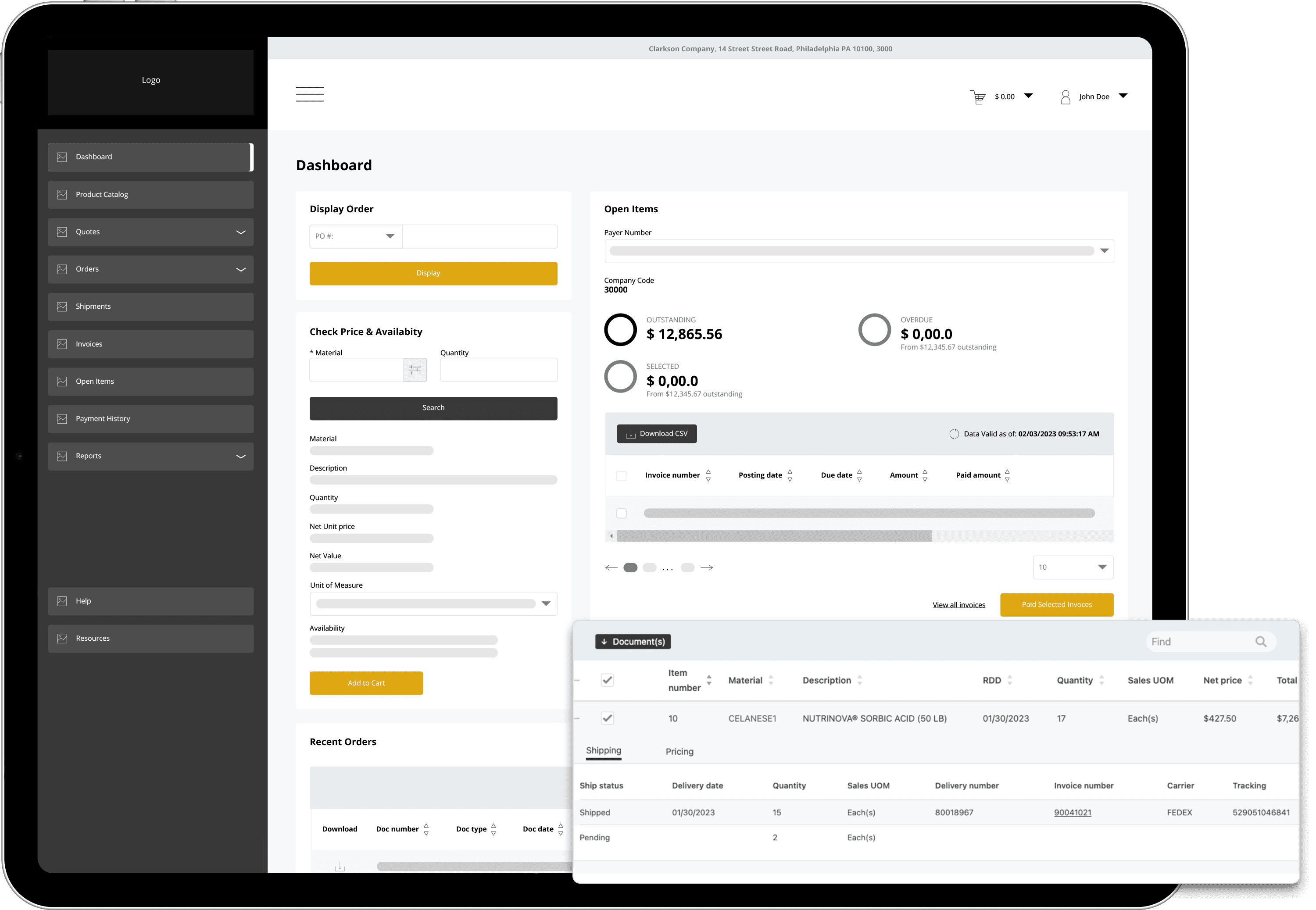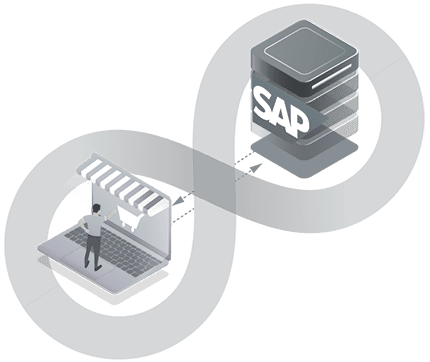Tackling SAP Integration For B2B eCommerce
How to launch a successful B2B web channel in an SAP ERP scenario
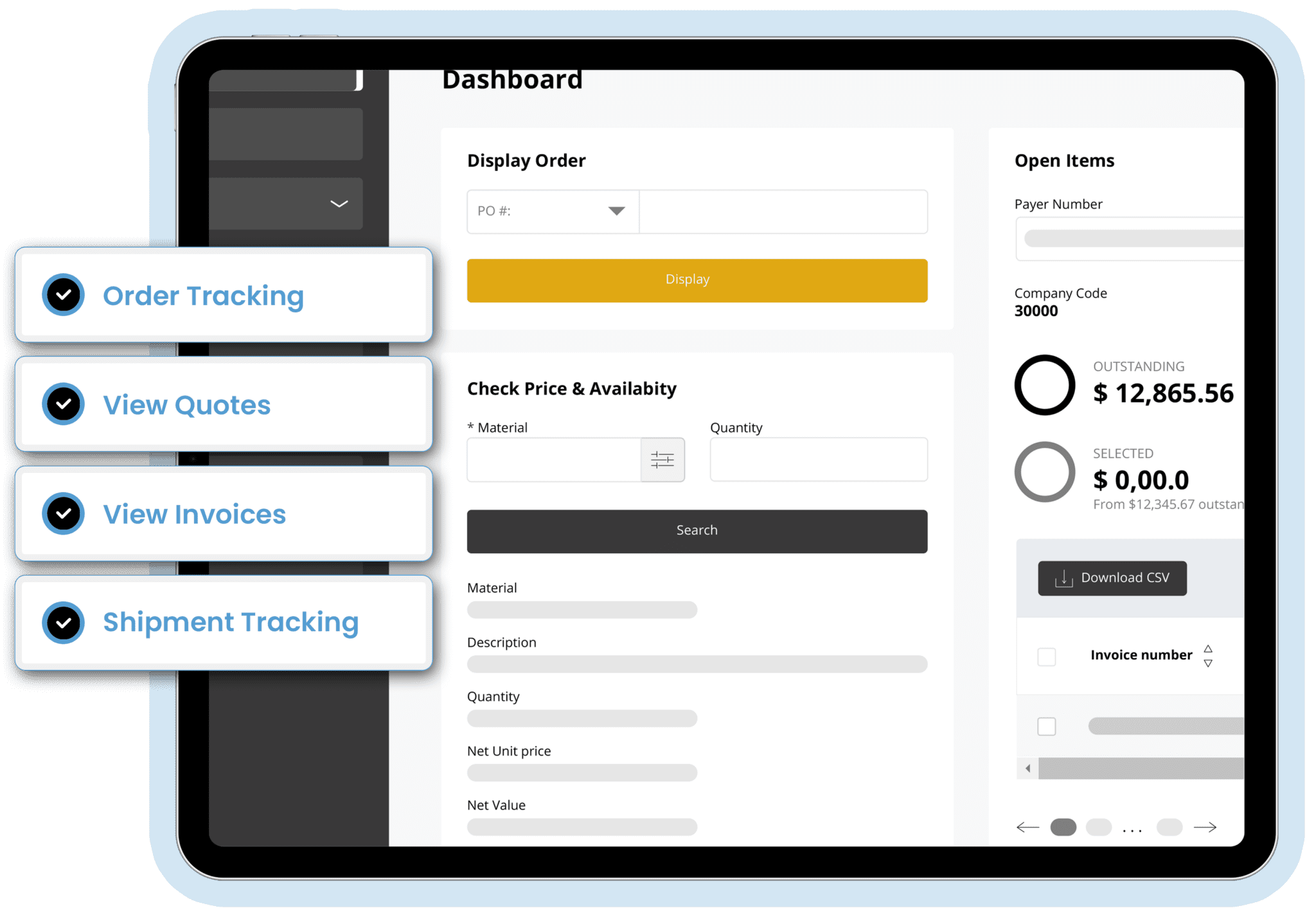
Whether you’re launching your first eCommerce initiative, overhauling an existing channel, or just gathering information, one thing’s for sure: SAP integration presents unique challenges in a B2B eCommerce scenario.
In 13 years of working with manufacturers’ B2B eCommerce channels, we’ve uncovered principles which every IT leader should consider when crafting an integration plan. In this whitepaper, we’ll examine those principles and help you build a plan for your organization.
Let’s dive in (click to jump):
1. Determine the depth of SAP integration required within eCommerce
2. Determine the scope of the customer journey which requires SAP integration
3. Determine your appetite for owning complexity
4. Let your SAP integration requirements guide your choice of platform
1. Determine the depth of SAP integration required within eCommerce
When it comes to SAP eCommerce, one question will define every aspect of your initiative:
Do your web customers need to interact with your SAP ERP system in real time as they build and place orders?
If you’re not sure, here’s a high-level list of eCommerce functionality which is only available in a real-time integration scenario. If you answer yes to any of these, you’ll need some form of real-time SAP integration to support your eCommerce transactions.
- Real-time inventory availability within the eCommerce portal, including any customer-specific inventory display rules
- Error-free order posting from eCommerce to SAP without human intervention
- Real-time credit status for customers within the eCommerce portal
- Real-time order status for customers within the eCommerce portal
If your customers need real-time SAP integration, then keep reading—we’ll help you explore your options and build a plan that fits your organization’s needs. We’ll talk about defining the scope of the customer journey which you want to cover, evaluating your integration options, and choosing an eCommerce platform.
If your buyers don’t need to interact with your SAP ERP system in real time, then you can pursue a conventional eCommerce project using a platform like Magento, Bigcommerce, Salesforce, or SAP Commerce Cloud, passing data to and from SAP via batch updates. To compare these eCommerce platforms in an SAP ERP scenario, skip to our platform comparison section.
2. Define the scope of the customer journey which requires SAP integration
Not every eCommerce solution is prepared to cover the entire customer journey with real-time SAP integration. You’ll want to define the scope which you’ll cover first, then look for a solution that can handle the entire scope.
For example, a conventional, B2C-style platform will obviously cover the basics of eCommerce—product catalog, cart/checkout, credit card payment at time of order placement, and order updates. If ERP interaction is required, it will usually take the form of batch updates between SAP and eCommerce.
However, in a B2B scenario (particularly for manufacturers), reliance on batch updates can create gaps in customer experience. Without real-time integration, a manufacturer’s channel partners can’t get crucial information or functionality which they need at that stage.
Here’s what that looks like at every stage of your customer journey.
I. Evaluation stage:
Real-time credit status. In a B2B scenario, credit status can make or break a transaction. Buyers need visibility into their current credit status so they know if the order they’re about to place will go on credit block. Alongside real-time credit status, you may want to offer the ability to pay down invoices (see below, “III. Post-order care stage”).
Real-time inventory/ATP availability in the catalog or cart. This data is generated by a complex calculation in SAP, and it’s often personalized for different customers. Because real-time changes in the underlying inventory quantity will modify each customer’s ATP calculation in SAP in real time, the eCommerce solution needs to get this information from SAP in real time.
Accurate contract pricing, including bundled/scaled pricing discounts. This data lives in SAP; and while it typically remains static (meaning it’s a potential candidate for batch updates), there’s less hassle and potential for bugs if pricing is pulled directly from SAP in real time. This is particularly true if you run promotional price changes which are defined in SAP, or if pricing fluctuates due to outside factors. With a direct, real-time integration loading pricing into the web store, you know eCommerce will always display the right price for every customer, no questions asked.
Personalized catalogs/picklists. In a B2B scenario, each customer often has an assigned list of SKUs which they’re allowed to purchase. If these picklists are rarely updated, they may be a candidate for batch updates. However, if a customer’s list of allowed SKUs changes, it’s simplest to run customers’ personalized catalogs in the web store off of real-time integration. That way, the web experience automatically reflects the state of SAP ERP as far as customer permissions.
II. Purchasing stage:
Accurate contract pricing displayed in the cart. Here’s where real-time integration really comes into play as regards pricing. If the price for one SKU is affected by purchasing another product, you’ll need real-time integration with SAP for the shopping cart. Otherwise, you’ll have to maintain those complex pricing rules in multiple places—SAP, your middleware solution, and eCommerce. That can harm the long-term viability of your eCommerce solution (see below, “3. Determine your appetite for owning complexity”).
Only 100% error-free orders posted to SAP. How many problem orders do you want to come from your eCommerce solution? None? Then you’ll need a real-time SAP integration in the eCommerce cart which checks the order for errors. A deep integration like this should capture any problem which might require human intervention from Customer Service—things like purchasing a disallowed or discontinued SKU, ordering a disallowed quantity, and more.
Intelligent error messaging returned to the user. SAP eCommerce is really only “self-service” if it empowers customers to build and place 100% error-free orders. A deep SAP integration should support intelligent error messaging returned to the user from SAP. That way, the customer can understand why the order can’t be placed—and how to fix it.
III. Post-order care stage:
Real-time credit status + the ability to pay down invoices online. In a B2B scenario, this is essential. Since buyers may place orders via PO (rather than paying immediately via credit card), they also need the ability to pay off invoices and keep their accounts in good standing. All of this requires real-time integration to SAP.
Full order history from all channels (not just eCommerce). In a B2B scenario, particularly for manufacturers, it may be difficult to eliminate older order entry methods like phone, fax, email, and EDI. Some customers will simply continue placing orders this way—or they may place orders through multiple channels. That’s why it’s important that the eCommerce portal should display orders from all channels. This gives customers a total view of their order history—plus it helps make the web channel “stickier.”
Real-time order/shipment status + shipment tracking numbers. This information lives in SAP, so if your eCommerce portal is going to provide 100% self-service, you’ll want to provide this as well. If buyers can’t get order status, shipment status, and live tracking number updates, they’re going to call Customer Service to get them, which drives up your cost of post-order care.
The Takeaway:
At every stage of the buyer journey, the manufacturer’s customers will pick up the phone or send an email if they can’t get this information through self-service. That kind of customer interaction requires human intervention. At scale, this drives up your cost of doing business and defeats one of the purposes of launching eCommerce (i.e., cutting unnecessary cost from your order-to-cash cycle).
3. Determine your appetite for owning complexity
Once you’ve determined how much of the customer journey you want to cover with SAP integration, you’ll want to evaluate your appetite for owning the complexity of SAP integration. At a high level, there are only 2 ways to build a digital portal solution that’s integrated with SAP in real time:
- Conventional, unmanaged eCommerce platform with 3rd party middleware system passing data back and forth (whether batch, real-time, or a combination) between SAP and eCommerce. (May not cover the entire customer journey in a B2B scenario).
- Managed eCommerce + customer portal solution that’s built on real-time SAP integration. A solution like this acts as an extension of ERP data and processes as they relate to customer self-service. It allows you to maintain this data in one place (SAP) rather than 3 places (SAP, middleware, and eCommerce). A solution like this covers the entire customer journey in a B2B scenario.
This is where many organizations reach a fork in the road. Let’s examine how each model works in detail.
Conventional unmanaged eCommerce platform + middleware integration
You own the complexity of 3 systems (SAP, eCommerce, middleware).
In this scenario, you choose an eCommerce platform like Magento or SAP Commerce Cloud, then select a middleware solution to pass data back and forth between eCommerce and SAP. You’ll have to maintain your SAP business rules and 3 places (SAP, middleware, and eCommerce).
In a B2B scenario with numerous complex business rules, this architecture creates a considerable workload distributed across 3 teams (eCommerce, middleware, and SAP). You’ll have to hire these resources internally or outsource the responsibility to 3rd parties.
That’s why this architecture is ideally suited to a B2C scenario, in which customer-specific business rules don’t come into play.
In a B2B scenario, where customer-specific business rules do govern transactions, we don’t recommend this architecture if your company does less than $5 billion in total annual revenue (more on that in our Platform Comparison section).
NOTE: Watch out for cost overrun from multiple vendors billing time/materials
Simply put, this architecture distributes responsibility across too many vendors. You’ll need:
- eCommerce platform licensing
- eCommerce SI to build your solution and support it after GoLive
- Middleware platform licensing
- Middleware platform implementation and support after GoLive
Unfortunately, most vendors in this space bill on a time/materials basis. However long it takes them to fulfill the scope, that’s what you’ll pay. While it’s easy to define the scope you need at the beginning of the project, it’s almost impossible for vendors to quote those hours accurately—especially if they’re building you a bespoke integration solution.
There’s a better way—choosing a managed solution that’s built on SAP integration.
Managed eCommerce + customer portal solution that’s built on real-time SAP integration
You own the complexity of only one system (SAP).
In this scenario, you choose an eCommerce platform which includes prebuilt, configurable integration to SAP. You maintain your business rules in one place only—SAP, where they’ve always lived.
This architecture saves you from making duplicate investments. Without separate databases for eCommerce and middleware, you don’t have to rebuild and maintain your existing SAP business rules in two places (which is a costly proposition, both during the implementation phase, and in the ongoing support phase). Instead, you leverage all of your relevant SAP investments in eCommerce without a third party sitting between the ERP and the web store.
This architecture is ideally suited to a B2B/manufacturing scenario, in which customer-specific business rules determine every aspect of the transaction. This is the architecture which we recommend for manufacturers in the $300M – $5B annual revenue range (see our Platform Comparison section for more).
4. Let your SAP integration requirements guide your choice of platform
In the latest B2B wave report (Q2 2020), Forrester suggests that organizations evaluating B2B eCommerce solutions should look for deep, prebuilt integrations in addition to features/functionality:
“More providers today offer proprietary app stores. However, the actual implementation of these add-ons can require everything from a few plug-and-play configuration clicks to a major developer-dependent implementation project. Look for ease of integration, meaning that: 1) the integrated solution is administrable within common tooling, and 2) changes are applied in real time and do not require batch processing or manual refreshes to take effect.” [emphasis ours]
For manufacturers running B2B eCommerce, integration to the ERP is essential for real-time inventory availability, enforcement of complex pricing rules, omnichannel order tracking, and more.
Manufacturers should choose a solution with depth of integration, overall cost, and staffing requirements that fit their business (and their budget). That’s why our B2B eCommerce platform comparison looks at two key dimensions:
- Company revenue, which generally correlates with the size of the digital channel (and, thus, correlates with the resources which you can spend on the solution)
- Depth of integration required
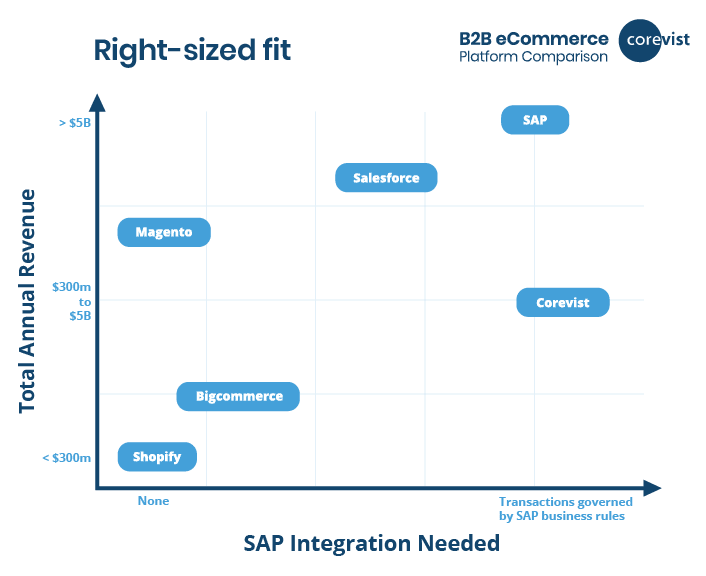


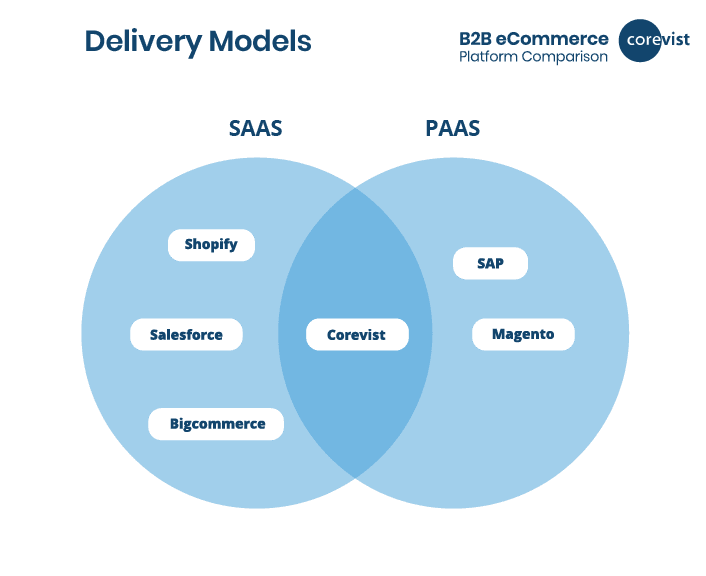
Choosing A Right-Sized Fit
Your organization’s total annual revenue correlates with the size of your digital channel (and, thus, correlates with the amount of resources you can spend on the channel). That’s why total annual revenue is a leading indicator of which B2B eCommerce solution will serve you best.
But total annual revenue isn’t the only factor to consider in evaluating solutions. If your organization is dependent on SAP ERP, you’ll want to consider the depth of integration which you’ll need to bring complex transactions to the web.
Here’s how each revenue bracket breaks down (click to jump):
1. Organizations with < $300M in annual revenue
1. Organizations with < $300M in annual revenue
Ideal platforms: Shopify, Bigcommerce
SMBs (small businesses) don’t need all the complexity of heavyweight platforms like Salesforce or SAP Commerce Cloud. The most important thing is a great user experience, the availability of prebuilt frontend widgets and 3rd party integrations, and limited responsibility for the eCommerce tech stack.
As market-leading SaaS solutions, both Shopify and Bigcommerce check these boxes. They’ll serve the small business well.
Magento could be a fit for organizations with <$300M/year total revenue, but with one caveat: Magento is a PaaS (platform as a service) solution, rather than SaaS (software as a service). You’ll need Magento developers, either in-house or outsourced through an agency, to build out, maintain, and support your solution.
That’s why we typically recommend Shopify or Bigcommerce for this revenue bracket. A true SaaS solution will allow you to focus on your business without taking on responsibility for the eCommerce technology stack.
2. Organizations with $300M – $5B in annual revenue
In our experience, most organizations in this revenue bracket fall into one of two groups:
- You just need a B2C-style front end without any SAP ERP integration for B2B
- Your business depends on SAP ERP, and the web experience must enforce personalized SAP business rules for each B2B user
1. No deep B2B integration required, just a B2C-style front end
Ideal platform: Adobe/Magento
If you fall into the first category, Adobe/Magento is a great choice. The solution offers everything which a midmarket, non-SAP-dependent organization needs to compete online. Magento’s world-class functionality allows you to replicate a B2C-style experience for B2B segments.
You get greater control of the solution than you would with Shopify or Bigcommerce, but you take on greater responsibility, too. With Magento, you’ll need an internal team of developers or an agency to build, launch, maintain, and support your solution.
At this point, you might be wondering how Magento squares up against Salesforce. Aren’t they going after the same market? You’re right, they are—and their pricing reflects that. All in all, you’ll spend roughly $500k/year for either Magento or Salesforce.
But for the $300M – $5B bracket, Magento has one disadvantage: it comes in at a similar price point as Salesforce, but it’s just commerce. Salesforce offers their flagship CRM solution, as well as other solutions, in addition to B2B eCommerce.
Magento delivery model: PaaS
Magento is a PaaS solution. You license the platform where you (or a Magento agency) can develop, launch, and manage your own unique Magento B2B eCommerce solution.
2. Deep SAP ERP integration required for complex B2B transactions
Ideal platform: Corevist
Corevist solutions were built to meet the needs of the $300M – $5B bracket—with direct, real-time SAP integration included.
Corevist client checklist:
- You’re between $300M – $5B annual revenue
- You’re looking for a heavily SAP-integrated solution
- You don’t want to involve extra internal/external resources in owning and managing the integrated solution
- You want to keep SAP ERP at the center of your world
We’re built specifically for manufacturers whose SAP systems run their businesses with complex, personalized business rules for each customer.
In fact, our solutions are so tightly integrated with SAP, we like to say they act as a customer-ready window into your ERP:
Each user gets a personalized experience driven by their SAP business rules—in real time. That means they get:
- Real-time inventory availability (or personalized ATP quantity, based on your business rules)
- Dynamic, personalized contract pricing (including all scaled pricing rules in SAP)
- Real-time credit status from SAP
- Full invoice, order, and account history from SAP (including order history from ALL channels—EDI, phone, fax, email, etc.—in addition to B2B eCommerce)
- And much more
Corevist delivery model: Hybrid SaaS / PaaS
Corevist’s delivery model is a mix of SaaS and PaaS. On the PaaS side, we offer a flexible platform with SAP integration architecture which supports commerce, order placement, order tracking, and invoice payment, all capable of interacting with SAP ERP in real time.
On the SaaS side, we maintain full responsibility for the cloud technology stack (integration + front end) that delivers your Corevist solution to your customers. You license the platform from us. As necessary, we customize our OOTB product to suit your needs, then launch and manage your Corevist solution(s) under a SaaS model.
FAQ: Why not just use Magento or Salesforce + middleware integration?
We’ve talked to many organizations in the $300M – $5B bracket who’ve gone down this road. Ultimately, if you do have a deep dependency on SAP ERP, standing up and maintaining a middleware integration to Magento or Salesforce may be a challenge. Whether in-house or outsourced, your organization will have to do some heavy lifting.
To bring your SAP business rules to the front end, you’ll need a middleware solution to transfer data to and from SAP and the B2B eCommerce solution. If you’re in the >$5B revenue bracket, the high cost and complexity of that middleware architecture may be justified. However, in the $300M – $5B bracket (where Magento plays), it’s often infeasible for organizations to get the integration off the ground (or keep it up and running).
Middleware-based architectures require your internal teams (or outsourced teams) to build and maintain your SAP business rules in 3 separate places—SAP, middleware, and eCommerce. That leads to a much higher cost than ~$500k/year (typical cost of Magento or Salesforce without SAP integration), as you’re retaining 3 separate teams, one for each system:

For the $300M – $5B range, the high cost and complexity of a middleware integration isn’t a trivial problem. An unreliable integration damages trust among customers, and the high cost of maintaining that integration (and thus, that trust) eats up too many resources for a midmarket company.
Without SAP ERP integration, the only other option is manual order entry. You’ll need CSRs (customer service reps) whose sole job is punching eCommerce orders into the ERP. While that’s a feasible process for small businesses with low order volumes, it’s not scalable, and companies in the $300M – $5B range usually find it unmanageable.

Only Corevist eliminates the cost and complexity of transferring orders and data between SAP and the web store. Rather than requiring manual order entry or a third system, Corevist interacts with SAP directly, in real time. This eliminates wasteful systems and processes in your OTC (order to cash) cycle.
3. Organizations with > $5B in annual revenue
Ideal platforms: Salesforce B2B Commerce, SAP Commerce Cloud
If your organization generates >$5B in total annual revenue, and you’re looking to spend $800k+ on a fully customized frontend solution (plus more on a custom-tailored integration to SAP ERP), then both Salesforce and SAP may be a good fit for B2B eCommerce.
Both Salesforce B2B Commerce and SAP Commerce Cloud are truly enterprise-class platforms. They offer tons of frontend capabilities for a powerful, flexible, B2C-style experience. You buy the platform, then use internal teams (or outsourced developers) to build out a solution using components and customizations tailored to your unique needs.
For $5B+ organizations, both Salesforce and SAP are well-positioned to act as a B2B eCommerce powerhouse.
Of course, with all this power comes great responsibility. As truly enterprise-class platforms, both SAP and Salesforce give you more control—and require you to take more ownership of the technology stack. Their implementations run large (often over a million dollars), and they each require dedicated teams to maintain and support.
For many organizations with >$5B total annual revenue, this higher cost, complexity, and responsibility is easily justified, as you get powerful frontend capabilities and enterprise-class functionality.
Delivery model: PaaS
Both Salesforce B2B Commerce and SAP Comemrce Cloud are PaaS solutions. You license the platform, then use it to develop, launch, and manage your own unique B2B eCommerce solution.
Sources:


